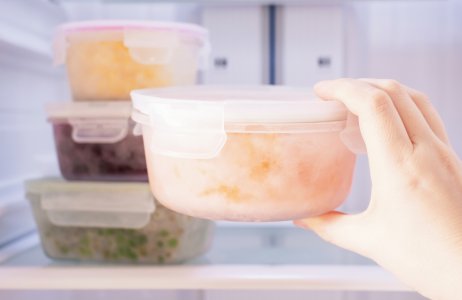Freeze like a Pro: The Ultimate Guide to What Foods to Keep or Toss in Your Freezer
By
Seia Ibanez
- Replies 5
As we navigate the hustle and bustle of daily life, finding ways to save time and reduce waste is more important than ever. For many of us over 60, we've seen the evolution of food preservation and the freezer has become a trusty ally in our kitchens. Whether you're cooking in batches to simplify your meal prep, or you're looking to extend the shelf life of your fresh produce, freezing is a fantastic way to keep your food for longer. However, not all foods take kindly to the icy confines of the freezer. Let's dive into the art of freezing, uncovering the best foods to freeze and those to avoid, ensuring your frozen fare remains delicious and safe to eat.
**Foods to Freeze: Your Cold Storage Companions**
When it comes to freezing, cooked foods are your best bet. Stephanie Partridge, an accredited dietician and senior research fellow at the University of Sydney, suggests that the texture and taste of food can change with freezing and defrosting, but certain foods handle the process better than others. Mariah Issa and Imogen Ashleigh Croucher, Master of Nutrition and Dietetics students supervised by Dr. Partridge, recommend freezing hearty meals like chilli con carne, beef stew, and chicken stir fry. These dishes tend to freeze and reheat well, maintaining their flavor and texture.
Roasted vegetables, fried rice, and even soups like pumpkin or minestrone are also excellent candidates for the freezer. If you're a fan of smoothies, freezing fruit is a great way to ensure you always have the necessary ingredients on hand. Just remember to freeze them in a single layer on a tray before transferring to a bag to prevent clumping.
**Foods to Avoid: The Freezer's Foes**
However, not all foods are meant for the deep chill. Foods with high water content, such as raw apples, celery, and spinach, don't fare well as they can turn mushy upon defrosting. Dairy-based products and eggs are also on the no-freeze list. These items can separate and develop undesirable textures when frozen, which can be quite unappetizing when thawed.
Dr. Partridge also cautions against freezing food that's on the brink of going bad. Freezing won't kill bacteria; it merely puts them into hibernation. When you thaw these foods, the bacteria will wake up and continue to multiply, potentially leading to foodborne illness.
**Storing Food in Your Freezer: Tips and Tricks**
Mark Weatherley from the William Angliss Institute, with his extensive experience in commercial kitchens, offers some valuable advice on storing food in your freezer. First, ensure that your containers or bags are freezer-safe. Look for the snowflake symbol or check the label. Portioning meals into smaller servings can save you the hassle of trying to hack off a piece from a larger block of frozen food. Shallower containers are preferable as they allow food to freeze and defrost more quickly and evenly.
When freezing meats like schnitzels or burger patties, do so individually to avoid creating a solid mass that's difficult to separate. A clear labelling system, including the date of freezing, is crucial to avoid mystery meals and to keep track of how long items have been stored.
**The Shelf Life of Frozen Foods**
While it might seem like food can live indefinitely in the sub-zero sanctuary, Dr. Partridge recommends a three-month timeline for most dishes. The Food Safety Information Council echoes this sentiment, noting that while food can technically be stored frozen for years without posing a food poisoning risk, the nutrient value and quality will deteriorate over time.
**Defrosting Do's and Don'ts**
When it's time to bring your frozen treasures back to life, safety is key. The Food Safety Information Council advises that poultry, rolled or seasoned meats, and boned meat joints should be thoroughly thawed before cooking to ensure they cook evenly throughout. Thaw cooked or ready-to-eat foods in the fridge or microwave, not on the bench-top, to minimize the risk of bacterial growth.

Freezing can be a game-changer for meal planning and reducing waste, but it's important to do it right. By following these guidelines, you can freeze like a pro, ensuring that your food remains safe, nutritious, and delicious. Have you had any freezing successes or mishaps? Share your stories and tips in the comments below – we'd love to hear from you!
**Foods to Freeze: Your Cold Storage Companions**
When it comes to freezing, cooked foods are your best bet. Stephanie Partridge, an accredited dietician and senior research fellow at the University of Sydney, suggests that the texture and taste of food can change with freezing and defrosting, but certain foods handle the process better than others. Mariah Issa and Imogen Ashleigh Croucher, Master of Nutrition and Dietetics students supervised by Dr. Partridge, recommend freezing hearty meals like chilli con carne, beef stew, and chicken stir fry. These dishes tend to freeze and reheat well, maintaining their flavor and texture.
Roasted vegetables, fried rice, and even soups like pumpkin or minestrone are also excellent candidates for the freezer. If you're a fan of smoothies, freezing fruit is a great way to ensure you always have the necessary ingredients on hand. Just remember to freeze them in a single layer on a tray before transferring to a bag to prevent clumping.
**Foods to Avoid: The Freezer's Foes**
However, not all foods are meant for the deep chill. Foods with high water content, such as raw apples, celery, and spinach, don't fare well as they can turn mushy upon defrosting. Dairy-based products and eggs are also on the no-freeze list. These items can separate and develop undesirable textures when frozen, which can be quite unappetizing when thawed.
Dr. Partridge also cautions against freezing food that's on the brink of going bad. Freezing won't kill bacteria; it merely puts them into hibernation. When you thaw these foods, the bacteria will wake up and continue to multiply, potentially leading to foodborne illness.
**Storing Food in Your Freezer: Tips and Tricks**
Mark Weatherley from the William Angliss Institute, with his extensive experience in commercial kitchens, offers some valuable advice on storing food in your freezer. First, ensure that your containers or bags are freezer-safe. Look for the snowflake symbol or check the label. Portioning meals into smaller servings can save you the hassle of trying to hack off a piece from a larger block of frozen food. Shallower containers are preferable as they allow food to freeze and defrost more quickly and evenly.
When freezing meats like schnitzels or burger patties, do so individually to avoid creating a solid mass that's difficult to separate. A clear labelling system, including the date of freezing, is crucial to avoid mystery meals and to keep track of how long items have been stored.
**The Shelf Life of Frozen Foods**
While it might seem like food can live indefinitely in the sub-zero sanctuary, Dr. Partridge recommends a three-month timeline for most dishes. The Food Safety Information Council echoes this sentiment, noting that while food can technically be stored frozen for years without posing a food poisoning risk, the nutrient value and quality will deteriorate over time.
**Defrosting Do's and Don'ts**
When it's time to bring your frozen treasures back to life, safety is key. The Food Safety Information Council advises that poultry, rolled or seasoned meats, and boned meat joints should be thoroughly thawed before cooking to ensure they cook evenly throughout. Thaw cooked or ready-to-eat foods in the fridge or microwave, not on the bench-top, to minimize the risk of bacterial growth.
Key Takeaways
- Not all foods freeze well due to changes in taste and texture, with high water content foods like raw apples, celery and spinach going mushy when defrosted.
- Cooked meals and certain fresh produce prepared appropriately, such as roasted vegetables and blanched veggies, freeze better than raw foods.
- Proper food storage in the freezer is key, using freezer-safe containers and labels for easy identification and portion control.
- It's recommended to consume frozen foods within three months for optimal quality, and to defrost food safely, ensuring it's completely thawed, especially poultry and stuffed meat joints, and to avoid defrosting on the bench-top.
Freezing can be a game-changer for meal planning and reducing waste, but it's important to do it right. By following these guidelines, you can freeze like a pro, ensuring that your food remains safe, nutritious, and delicious. Have you had any freezing successes or mishaps? Share your stories and tips in the comments below – we'd love to hear from you!








